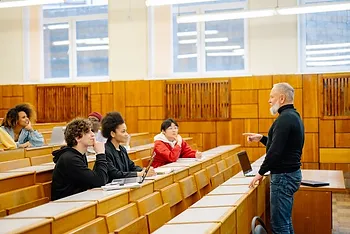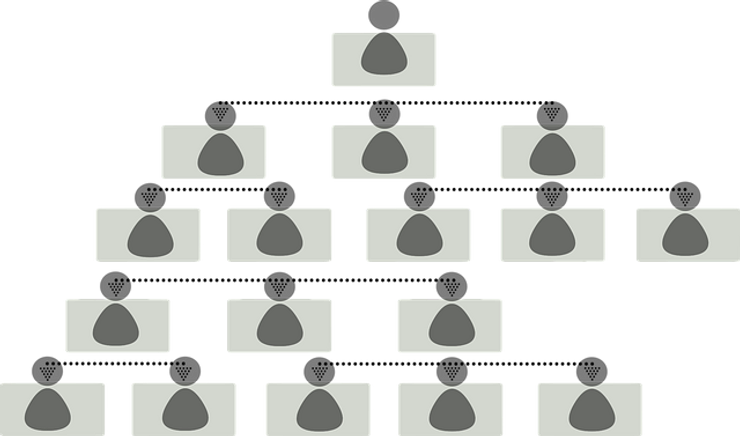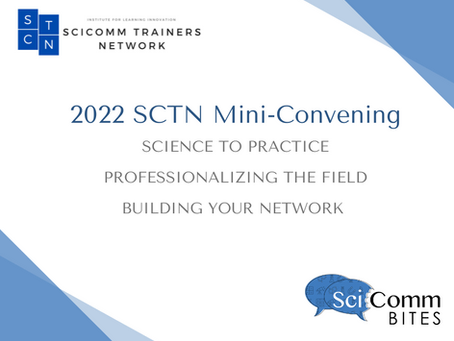SCTN Mini-Convening Coverage
By Kay McCallum
SciCommBites attended the SciComm Training Network’s Mini Convening on June 14, with themes of Science to Practice, Professionalizing the Field, and Building Your Professional Network. Here is coverage of the three sessions.
| As a researcher, it’s easy to get caught in a niche – you write for your very specific audience, and it’s expected no one else outside your area of expertise will really follow along. At this Mini-Convening I not only learned about new skills and tools I could employ in building better sci-comm experiences, but I was also reminded of how important it is to meaningfully connect with people both in and outside my field and how to do so most effectively and conscientiously. |
Using LinkedIn to be a Powerhouse Networker
Time to dust off that LinkedIn account – in this session, Sara Kobilka, founder of Renaissance Woman Consulting, shared some tips and tricks for how to maximize engagement and build connections on LinkedIn.

At a glance, the platform can be daunting, as it combines all the best (and, arguably, the worst) aspects of posting and friending on Facebook with building your resume. How do you use LinkedIn effectively? How do you even get started? Kobilka breaks it down into three objectives:
- Make Connections Effectively
- Build Your Page
- Plant Flags
1. Make Connections Effectively
LinkedIn is, at its core, a professional networking platform. So what’s the best way to expand your network? Kobilka differentiates here between two features on LinkedIn: connecting and following. Connecting is akin to a friend request or a mutual follow, whereas following just allows you to get their content in your feed.
It may be tempting to connect with every person on LinkedIn, but it’s not necessarily an effective method – connections, Kobilka cautions, should only be made with people you actually have a connection with, or a reason to be connecting. If you want to learn from them, or if you find their content interesting, following may be your better option. By reserving connections for relationships that are meaningful and beneficial, your professional network can expand productively – and don’t be shy about turning down connection requests that don’t work for you.
As you make connections, Kobilka reminds us of the most important step: add a note! This personal touch helps you both keep track of where and how you met, and most importantly, why this connection matters. LinkedIn is like a professional rolodex, Kobilka argues, so make sure you put your connections in writing!
2. Build Your Page
LinkedIn boasts a lot of content on its profile pages, and it certainly takes some time setting it up. But perfecting your page is just as important as building your network – Kobilka highlights some key areas of focus that will help you get the most out of your account.
In addition to the profile picture and resume blocks, LinkedIn offers a headliner (akin to a snappy Twitter bio), a customizable profile URL, and robust privacy settings that allow you to control how – and to whom – you advertise your content. These sections are critical to making LinkedIn work best for you, so make sure you spend time setting them up! In “Open To,” you can advertise your openness to new employment opportunities, and the privacy settings allow you to ensure that unwanted parties (a current employer, perhaps?) can’t see your job hunt.
The Services and Experience section allow you to highlight what you’ve done and what you can offer. Kobilka has a lot of occupational experience, and has listed them all on her page, but keeping it short, sweet, and recent is also an effective way to use the page! Services allows you to discuss your marketable abilities in more general terms – this section can get a bit business-buzzwordy, but it can showcase your skills in a different way than a former job listing. And in the Featured section, you can highlight those projects you’re particularly proud of.
3. Plant Flags
So you’ve built your network and tricked out your page – now what? Kobilka says it’s time to put your hard work to work for you. Any form of engagement – posting, reposting, liking, commenting – brings your name back into people’s feeds. These flag-raising actions keep you in the peripheral vision of your connections, which can thereby drive opportunities for jobs, collaborations, and more.
Engagement, importantly, is not content creation – although LinkedIn offers many opportunities for creating content, such as posting, newsletters, and going live. But even if posting every day isn’t feasible for you, you can keep your engagement up by interacting with content you find interesting or salient. Kobilka may not post every day (how much you post really depends on what’s realistic for you and how you want to use LinkedIn), but she recommends at least signing in and engaging, just to keep your name relevant. Your Analytics on your page are useful to determine how much engagement you’re driving with your page and is a great resource to track your own growth – but careful, it should only be used as a self-metric and not compared against others!
And, as a final note, Kobilka reminds us to turn your notifications on – don’t let your hard work setting LinkedIn go to waste by missing all your connections and updates! (And while you’re logging in and trying out Kobilka’s tips and tricks, consider joining the SCTN LinkedIn network!)
Evaluation Approaches for Inclusive Science Communication Training
Recently, science communication training programs have highlighted the need for justice, equity, diversity, and inclusivity (JEDI) in their design – but how do you determine if your program properly implemented JEDI practices into its framework? In this session, Evelyn Valdez-Ward and Sunshine Menezes share their work on reimagining science communication programs for marginalized groups.
Culturally Inclusive Science Communication
Our culture shapes how we interact with the world, and cultural norms determine the standard for interaction – and when these norms are unjust, inequitable, and exclusionary, they freeze anyone who does not fit the norm out of participation. In STEM, for example, cultural norms shape the prevailing idea of who can be a scientist and who is welcomed and successful in these spaces. And, Valdez-Ward and Menezes point out, science communication reflects the cultural norms in STEM. Training programs in science communication end up lacking diversity in both trainers and trainees, accessibility, and inclusion.

Although many programs are actively trying to overcome this, the methods in the field to-date tend to be ad hoc at best, as there currently is no standard method for evaluating the efficacy of culturally-inclusive sci-comm training. There are no long-term assessments of the impact of these programs; and if a program is evaluated, it is often done via anecdotal self-reporting – leading to overconfidence biases. The skills trainees learn aren’t actually evaluated.
It’s clear that there’s a need for standardized evaluation in this area, but Valdez-Ward and Menezes note that many problems exist in creating a universal evaluation tool: programs differ in length, skills, audience, implementation of JEDI, and delivery method, just to name a few variables. There are a number of evaluation methods that could be used, and lack of resources to implement them. And, how do you even define “effective science communication?”
Culturally Relevant Pedagogy in Sci-Comm
Gloria Ladson-Billing’s theory of culturally relevant pedagogy describes a form of teaching where students not only achieve academically, but are also affirmed in their cultural identities (cultural competence) and gain a critical social awareness of cultural structures and institutions (critical consciousness). Valdez-Ward and Menezes use this as a framework by which to create inclusive science communication training and evaluation tools:
- Academic Excellence: in Ladson-Billing’s model, this is achieved by teachers incorporating student cultures into classroom settings, thereby creating a more welcoming and inclusive environment for students. In adapting this, Valdez-Ward and Menezes posit examining what participants need to succeed, how success should be defined, and how to measure the skills they learn.
- Cultural Competence: here, students are affirmed in their own cultures, but also able to expand their boundaries and interact with other cultural frameworks. In adapting this to sci-comm, Valdez-Ward and Menezes look at critically examining the cultural norms of a space, questioning whether these norms foster a sense of belonging in all participants, and changing the curriculum to do so.
- Critical Consciousness: students are enabled and empowered to critically analyze existing power structures and inequities in society with power to effect change. Valdez-Ward and Menezes examine the science communicator’s role in society, what cultural inequities may affect participants, and what science communicators can do to help.
Science Communication Identities Project (SCIP)
So what might a culturally-relevant sci-comm training program look like? Valdez-Ward and Menezes share their work on SCIP, a new program from the University of Rhode Island and Michigan State University implementing intercultural communication theory in a science communication training program. As part of its research into culturally relevant sci-comm training, SCIP will be conducting interviews with STEM faculty of colour to determine how these faculty navigate academia and the inequities and barriers they face, and developing culturally relevant curricula that respond to these barriers.
In addition to this, SCIP is creating a one-year fellowship for pre-tenure faculty who identify as underrepresented racial or ethnic minorities, to give fellows skills in science communication, encourage the development of these skills in faculty research groups, and add value to science communication. As part of the program, fellows will participate in the development of the first peer-reviewed podcast in the United States. The fellowship will have three cohorts, each corresponding to a different theme in climate change; applications for the 2023 cohort (energy) are currently open!
What You Can Do
Beyond building new programs and evaluation tools, Valdez-Ward and Menezes highlight the need to normalize culturally relevant sci-comm. SCTN attendees noted that encouraging diversity in hiring, constructing culturally relevant curricula, and empathizing with your audience are a few ways we can do so. This will take a lot of work, and more than a little trial and error, so attendees also encourage sharing resources and lesson plans, providing feedback, and following up with further discussions on how others have implemented inclusive practices into their training programs. In doing so, we can all build more just, equitable, diverse, and inclusive science communication training programs.
Apply Reflective Tools to Level-Up Your Public Engagement Practice
Ellen Kuhn and Elyse Aurbach define public engagement as broad impact work between members of an institution or field, and groups outside it. A lot of fields do public engagement work, and science communication is no exception – but every field seems to discuss public engagement a little differently, and this lack of a universal language can hinder content creation. Furthermore, with multiple collaborating parties on any particular project, it can be difficult to keep track of everyone’s objectives, abilities, and needs, and managing good working relationships.
In this session, Kuhn and Aurbach highlight the Michigan Public Engagement Framework (MPEF) reflection decks, a series of organizational and reflective tools for creating public engagement initiatives created at the University of Michigan. These decks support deep introspection into the initiative through three universal themes
across all forms of public engagement:
- Context, or what you’re making;
- Partners, or who you’re making content with; and,
- Relationships with your collaborative partners.

Context
Public engagement initiatives are all each a little unique, based on the form of the content and the objectives involved. Who is your target audience? What form will the initiative take place? Where and when is this content being exhibited? How are you exhibiting it? Why are you making it? Even a seemingly small question like “what do you expect the impact of this project to be?” becomes remarkably complicated when you break down impacts on the audience versus various collaborative partners, and the same content delivered in a different context – policy advocacy versus high school education, for example – requires different setup and delivery.
The Contexts Deck provides an avenue to deep dive into these questions and strategize content creation, by inviting opportunities to define the objectives of the activity, determine which groups, partners, and people need to be involved to implement it, and dissect the anticipated impacts (both intended and resultant) and the scale of the activity. This deck demystifies content creation, and ensures you know exactly what you’re building, how you’ll build it, and why.
Partners
Public engagement isn’t created in a vacuum, and projects of any size involve multiple parties to implement. But while everyone may be working toward a similar goal, they may not have similar reasons for being there, or similar objectives and outcomes for the activity. The Contexts Deck helps you identify who your partners may be; the Partners deck invites you to take it a step further and empathize with your collaborating partners. What sort of abilities and resources can a partner bring to the project, and how relevant are these resources in implementing it? Are there any gaps in what you may need? What do you bring? What sort of risks, limitations, or barriers may your partner face in collaborating with you on this project? This deck helps you determine not only which groups are effective collaborators and how they can best support the project, but also identify how you can best support them.
Relationships
As anyone who’s worked on collaborative initiatives knows, working relationships can sometimes be difficult to manage if not everyone is on the same page. The Relationships Deck builds on the Contexts and Partners Decks by helping you negotiate the relationships you hope to achieve with your partners. What values (such as power sharing, inclusivity, or credibility) do you find most important in your relationship with a partner? What do you think they might value? How is the workload being split, and how is the chain of command determined? This deck will enable you to create more effective partnerships with your partners to best implement your activity.
How to Use the Decks
To use the decks most effectively, Kuhn and Aurbach recommend a simple process:
- Quickly outline your project and who’s engaging with it
- Interact with the elements of the deck that best suit your needs
- Brainstorm answers to questions asked in the deck
- Dive deeper into those answers
- Summarize what you covered
The modular form of the decks provide maximum flexibility in interaction and ensure that this resource works best for what you need. Although the three decks work well together, you can interact with each individual deck as needed, and in a variety of forms. Kuhn and Aurbach recommend using the decks in early stages of team building, as they can help negotiate roles and values in new group formation. The decks are available as print-at-home decks, workbooks, or digital resources and can be found here.
Edited by Jacqueline Goldstein
Images by Yan Krukov (via Pexels) and geralt (via Pixabay).

